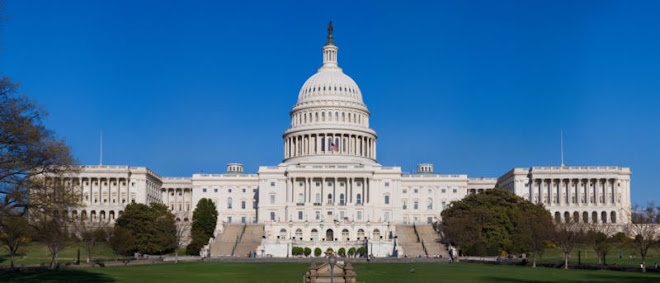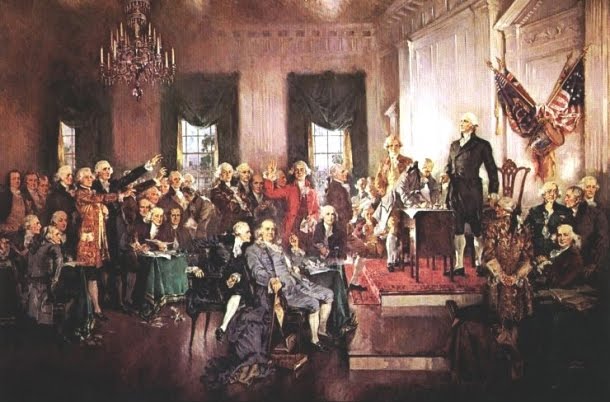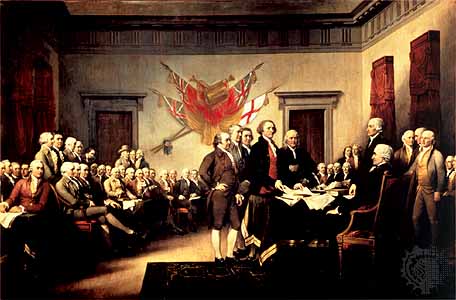From the Institute For Policy Innovation and The Heritage Foundation:
IPI Issue Brief
Federalism: The Founders' Formula for Freedom
by Congressman Rob Bishop on 05/18/2010
5 Pages Synopsis
Full Text PDF
Inside the House chamber in Washington D.C., the upper wall is surrounded by the cameos of all the world’s great lawgivers. Moses, as the greatest lawgiver, is the only one with a full face. The others are all side views. The only Americans included are Thomas Jefferson and George Mason, and, ironically, neither signed the Constitution. Mason was actually one of three men who stayed for the entire Constitutional Convention and then refused his assent to the finished product. When I taught high school, I insisted my kids know why Mason refused to sign. He objected to the document because it did not contain a Bill of Rights. I always hoped, in vain, that some bright student would ask the more pertinent question. The better question would have been not why Mason refused to sign, but why such patriots as Washington, Franklin, Hamilton, Madison, Dickinson, Wilson, etc., objected to Mason’s request?
The Founding Fathers were certainly not opposed to Mason’s goal of protecting individual liberty. They wanted the exact same goal, but had different ideas of how to best achieve that goal. A little context may help understand the Founder’s views on this matter.
Theories of Government
Most governments at the time of the Constitutional Convention were unitary governments. Unitary means the source of power resided in a central power. The United Kingdom still is unitary government, since Parliament rules as the ultimate source of authority or power for the entire island. In Britain, all three government functions—legislative (making laws)/executive (administering laws) and judicial (adjudicating laws) —are invested in the British Parliament. It is certainly an efficient system. Unitary government is not a totally foreign concept in America either since all U.S. states are unitary. State governments have unlimited authority within the states.
The exact opposite is confederal power. Confederal systems reserve power to the individual units of government. The Articles of Confederation maintained the source of power in the individual states, not the national Confederation Congress. The Confederate States in the Civil War tried the same philosophy, which was one of the problems the South faced in executing a war strategy that required individual states to agree on collective use of scarce resources.
The U.S. Constitution decided to take a middle course of “biformidy,” a combination of unitary and confederal power. No title clearly described what America created, so the framers captured the word “federalism,” and transformed the meaning into a description of this new form of government. This form was essential to maintaining the Founding Fathers’ desire to ensure personal liberty by constitutional structure. The Founding Fathers created a horizontal separation of powers to divide power between the three functions/branches (executive, legislative, judicial) of government. Most refer to this as a “separation of powers.” But even more important was the vertical separation of powers, now called federalism, that provided balance between state and national government power. This new concept of government was not specifically named in the Constitution, but was central to the constitutional system. Indeed, the vertical separation of powers was the unique element in the U.S. government system.
Federalism: Structured Freedom
While George Mason insisted on a written list of prohibited practices (a Bill of Rights) to protect citizens, the rest of the Constitutional Convention chose the structural concept of federalism and separation of powers as the means to ensure citizens’ liberty was protected.
However, this power balance was not just another word for government gridlock. The U.S. style of federalism (biformidy) and balance of power were two complementary strands of power separation—one horizontal and one vertical. The purpose of both horizontal and vertical power balance was to protect individual liberty, the goal the Founding Fathers had in mind when they wrote the Constitution. They believed the only way to preserve individual liberty was to check government power. Each branch would check the other branch of the new national government. However, since a national government might not check itself, the national government must also be checked by the states. The 50 states were to be a counterbalance to the national government.
Federalism/separation of powers was the vehicle designed to protect people. In Federalist 51, Madison admitted that citizens of the country had the primary responsibility to protect their own rights and “a dependence on the people is, no doubt, the primary control on the government, but experience has taught mankind the necessity of auxiliary precautions.” Separation of powers, both vertically and horizontally, was the “auxiliary precaution.” Madison, in Federalist 45, also envisioned how the vertical separation of powers (federalism) was to operate. He wrote, “The powers delegated by the proposed Constitution …are few and defined. Those which are to remain in the state governments are numerous and indefinite….The Powers reserved to the several States will extend to all the objects which…concern the lives, liberties, and properties of the people…”
In federalism, states had real power. Federalism did not mean the national government would graciously allow the states to do something. Federalism was when the national government and the state governments had the ability to frustrate, but not control, one another. In Federalist 32, Hamilton argued that, a “conviction of the utility and necessity of local administration for local purposes…would be a complete barrier against oppressive use of such (national) power.” He further wrote, “Under the plan of the convention, (states) retain that authority in the most absolute and unqualified sense; and that attempt on the part of the national government to abridge (any state power)…would be a violent assumption of power, unwarranted by any article or clause of the Constitution.”
While largely a new political concept, American-style federalism had roots in the Old Testament. Moses developed the concept of federalism in Exodus 18:13-26. As Moses worked to exhaustion dealing with all the issues brought by the children of Israel (a unitary government), his father-in-law insisted he delegate authority to captains over groups of thousands, hundreds and tens. Only the most unusual issues were to be brought before Moses. This new system of administration divided authority among manageable units. It allowed problems to be solved on the level where the problem originated—in other words, government closest to the people governed best. That was essentially federalism.
Limitation of the National Government
The Founders understood that the national government’s only inherent advantage is uniformity. If everything has to be exactly the same in every corner of the country, if all have to walk the same way and talk the same way, then the national government is the perfect venue to accomplish that task. The national government could pre-empt the states and force uniformity. If, though, creativity is needed, the states and not the national government are the venue of choice. The states are the only level where innovation occurs. States have the ability to explore options without the danger of a wrong experiment destroying the entire nation. State and local governments are the only levels that could encourage creativity. The national level has too many layers of bureaucracy to encourage thought outside the proverbial box. Nelson Rockefeller used to talk about the deadening hand of bureaucracy destroying new programs. He was right.
The vertical balance of power between the national government and state governments was the critical component of our constitutional system of government. Over time, however, Congress and the courts slowly chipped away at the vertical separation of powers. Beginning with the Progressive Era, the American system changed and the principle safeguards of federalism were weakened. Today, most people are unfamiliar with the meaning of federalism, or of its foundational role in our system of governance. Sadly, this benign neglect includes many of our national leaders.
A Federalist Goes to Washington
When I was first elected to Congress, the newly elected members of Congress met for a two-day retreat to find a common theme or goal. We had presentations on the flat tax, national sales tax, urban revitalization and federal mandate elimination. Ultimately, the group accepted those ideas as worthy but decided to focus attention on budget “waste, fraud and abuse.” I could never get excited enough to join on special orders presentations of “waste, fraud and abuse,” because I thought the topic a cliché. The philosophical goal of this effort was to make a large national government more efficient. I didn’t want a more efficient national government, I wanted less national government. As part of my presentation I sent the following letter to each freshman:
“Our founding fathers had two mechanisms to protect individual rights.
The least effective measure was Article 1 Section 9 and the Bill of Rights. Both were specific actions for which the state was prohibited. Actually, the first ten amendments have been misnamed. They should be the Bill of Wrongs – that which is wrong for the government to do regardless of how many people desire it. This approach has limited efficacy because
one can’t list everything.
The more effective measure adopted at Philadelphia was to structure government to meet the goals of liberty preservation. We call it “separation of powers” and usually teach only half of the concept to school kids. We always talk of a separation of powers which is “horizontal” between the three branches of government. That is true, but the founding fathers also gave us a “vertical”
separation of powers between the state and federal government levels. The framers of the Constitution had designed a deliberate system of constant, balanced tension between state and federal levels. The purpose was to protect individual liberty, therefore, whenever this structure is out of balance, individual liberty is placed in jeopardy.
The balance of power concept has been seriously eroded in recent years, especially the “vertical” separation of powers. Many of us have had experience in state legislative bodies. Repeatedly we made decisions based not on what was best for the state, but on what types of federal match were available. More pernicious were the decisions based on the threat of federal funds withdrawal. In this year’s Utah legislature the primary argument against two bills was not the merits of the ideas but the amount of federal funds which might be withheld. I could point to the overpass built solely because of a 10 to 1 federal match opportunity. I can point to a computer system the state neither wanted nor used, but bought because of the risk of losing federal money. Every state can easily replicate these examples.
Two groups are responsible for this situation. Power hungry congressmen have dangled “free” federal money in front of cash starved states for 60 years. Each piece of greenback bait dangled before a state legislator was accompanied
with the promise of financial salvation. When the bait was taken, the federal government reeled in the states with mandates on everything from the computer program to motor cycle helmet. The federal government tipped the vertical separation of power in favor of Washington and endangered the liberties of all Americans in the process.
The second group, states, had been abused, but is not blameless. Starting in the mid-1960’s states freely gave up their self-determination for the cheap fix of free federal money and accompanying mandates. States should have
been strong and declined the federal fix, but regardless of blame for this situation, the fact remains that individual liberty is threatened by the absence of a power equilibrium between state and federal levels. This should be unacceptable to all.
Enter the Republican freshman class.
Now would be an ideal time to strike a blow for individual liberty and correct the federal-state balance. As freshmen we should:
1. Find at least one funded federal mandate or financially matched grant program for states or local governments to be replaced with a long-term block grant program area which would reward creative state solutions. Creativity in government is the inherent advantage of state or local government autonomy.
2. Find at least one unfunded federal mandate to eliminate.
Our battle cry will be the commitment to ‘lose power.’ We will return home for re-election proud to have made a step re-establishing the Constitutional “vertical” separation of powers concept. We will return proud of voluntarily relinquishing federal control. We will return proudly having lost power in Congress. We will also have struck a blow in defense of individual liberty.”
Much to my chagrin, this battle cry did not rouse the troops. Republicans in Washington, so long out of power, were not in the mood to lose the power they had so recently gained.
Giving up Power
Not long after the freshman members’ conference, I attended a retreat in Baltimore. As a newcomer to Congress, I tried to be quiet and listen. The topics and goals were all items with which I agreed. They included budget reform, deficit control, abortion, school vouchers, and social security. The list was comprehensive. Toward the end of the retreat, Congressman John Culberson of Texas introduced a new topic. He tried to plug a group of bills supporting 10th Amendment rights of states. I was thrilled, but apparently the only one in the room—besides Culberson. The rest of the group didn’t dislike what he said, but they gave only scant attention, more concerned about the hotter topics of the retreat. I should have spoken out, but did not. All the issues discussed were significant and the body wanted to move in a conservative manner. There was not an issue, though, that could not have been overturned by a future Congress. I concluded that we really were still part of the problem—a kinder, gentler part to be true—but a part of the problem nonetheless. Rep. Culberson was the only one talking true systemic reform of Congress. He was proposing the most radical of Washington ideas: giving up power.
There are several types of conservatives. One type wants the government to be more efficient, effective and cheaper. This is a kinder, gentler control of people’s lives. I am not this type. I am another type of conservative, one who believes the site of the decisions must be moved from Washington to state government.
Earlier, the sponsor of the meeting asked each member to introduce himself and tell why he first ran for Congress. As typical verbose politicians, there was not enough time for more than a quarter of the participants to respond. I did not introduce myself. I knew what I would have said, but only later I realized my answer would have been a response to this situation. Candidates were trained to tell potential voters the candidate deserved their vote because the candidate was the best choice and was going to win. That was always the good answer. I concluded that my real answer was I wanted to lose—lose power. As a classroom teacher for over 20 years, I wanted the national government out of my room. As a state legislator, I wanted the national government out of my budget. With 67 percent of Utah owned by the national government and the rest regulated by the national government, I wanted Washington out of my state. I wanted the national government out of the all pervasive interference in every aspect of my life. I wanted to leave Congress with less power than I had when I entered. Congressman Culberson and a handful of others were the only ones who got it right.
Federalism Today
Our country is at a crossroads. A recent poll found that four out of five Americans don’t trust Washington. Another poll found that a full 86 percent of Americans think the federal government is “broken.” The Founders of this country were healthy skeptics of a powerful, centralized government. They sought to establish a national government that would do a few things well. Today, as the polls attest, we have a national government that does many things, poorly.
Americans are ready for change—real change that gives them, not Washington, greater control over their own lives. They don’t want new leaders in Washington running a slightly less intrusive government. Instead, Americans of all political stripes want more choice, greater accountability, and a more flexible and responsive government. That is precisely what federalism can deliver.
I am convinced the best way to demonstrate commitment to real change is by embracing federalism. Only by pursuing a federalist agenda can we disperse power from Washington, promote liberty and limited government, provide greater choice and deliver a more effective and responsive governance to the people.
Leaders in Washington need to show the American people that we have a comprehensive plan that doesn’t impose a certain ideology or party platform on them. Instead, we need to tell them that decisions should be made locally, by individuals living in their communities, not by politicians in Washington. Federalism is not a concept of either the right or the left. It is not a Republican or a Democrat idea. Both sides have something to gain under a federalist revival. We may disagree with some of the decisions some states ultimately make, but we must stand firm to the belief that the Constitution was designed in such a way that gives the people the power to make those choices.
A Golden Age of Federalism
Many advocates of national solutions do not believe federalism can work today. They believe that today's complex modern society can only function properly when the national government establishes the rules. They’re wrong. As LaVarr Webb of Utah Policy Daily has said:
It is precisely the Information Age, the Internet Age, that could enable a new, golden age of federalism. Today, states and local governments can operate in an intelligent network, collaborating, cooperating, adopting “best practices,” creating an upward spiral in competency, improved management and delivery of services. They can adopt standards and pass model legislation to provide needed consistency for multistate businesses. With the amazing power of networking and advanced tools of technology, states can fulfill Justice Louis Brandeis’s vision as laboratories of democracy. Most breakthroughs in governance are already coming from the states. Could such innovation, creativity and energy ever be spawned by the top-down, mainframe dinosaur that is Washington? Federalism can actually perform better in the age of Google and Facebook than it did 200 years ago.”
We are a nation of creativity, of diversity, of freedom. We need innovators and a new generation of ideas. Let us learn from the successes and the failures of one another. This nation is too great, too broad, and too diverse for one set of ideas to rule from sea to sea. California is not Kansas. Alabama is not Alaska. And Massachusetts is not Utah.
Federalism is the answer. Federalism gives people choice and options. Federalism keeps government within the reach of the individual, and keeps government in its place. Today, the people have no control over the vast federal bureaucracies. Federalism is the mechanism by which power can be returned to the people.
I am convinced that now is the time for a federalist agenda because federalism is simply the best, and the constitutionally based bastion for limited government, choice and individual liberty.
_____________________
Congressman Rob Bishop has represented Utah since 2003, and is the co-founder of the Congressional 10th Amendment Task Force.
--------------------------------------------------------------------------------
A READER ON THE STATE OF THE POLITICAL DECAY AND IDEOLOGICAL GRIDLOCK BETWEEN ONE GROUP WHO SEEK TO DESTROY THE COUNTRY, AND THOSE WHO WANT TO RESTORE IT.
The Rise and Fall of Hope and Change




Alexis de Toqueville
The American Republic will endure until the day Congress discovers that it can bribe the public with the public's money.
Alexis de Tocqueville
Alexis de Tocqueville
The United States Capitol Building

The Constitutional Convention

The Continental Congress

George Washington at Valley Forge



No comments:
Post a Comment